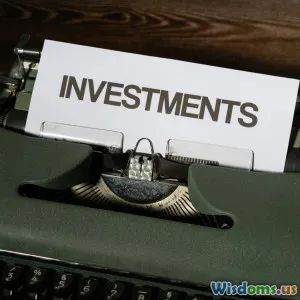
Crowdfunding Success Stories That Raised Over One Million Dollars
7 min read Explore inspiring crowdfunding campaigns that surpassed $1 million, revealing strategies and lessons from their success. (0 Reviews)
Crowdfunding Success Stories That Raised Over One Million Dollars
In the dynamic landscape of crowdfunding, reaching the one-million-dollar mark can seem like an elusive goal, reserved for only the most innovative or widely appealing projects. Yet, several campaigns have broken boundaries and shattered expectations, not just meeting but vastly exceeding this milestone. What is it that propels these fundraisers into the stratosphere of success? This article explores real-world crowdfunding triumphs, unpacking their stories, strategies, and lessons that aspiring campaigners can harness to elevate their own projects.
Introduction: The Allure and Challenge of Crowdfunding
Crowdfunding platforms like Kickstarter, Indiegogo, and GoFundMe have democratized access to capital, giving entrepreneurs, artists, and innovators a stage to pitch directly to backers worldwide. While millions of projects launch these days, only a select few soar past the coveted million-dollar threshold. Understanding their pathways offers a blueprint for success in a crowded market.
Proven Million-Dollar Success Stories
1. Pebble Technology: Pioneering Smartwatches
One of the most iconic crowdfunding campaigns in history, Pebble Technology revolutionized wearable tech fundraising. In 2012, Pebble raised over $10 million on Kickstarter, making it then the most funded project ever.
Key Takeaways:
- Timing and Market First Mover Advantage: Pebble entered early into the smartwatch space, captivating tech enthusiasts hungry for innovation.
- Compelling Storytelling: Their clear vision—the ability to receive notifications, track fitness, and customize with apps—resonated deeply.
- Strong Community Engagement: Pebble actively engaged early backers, offering regular updates and feedback loops, establishing trust and buzz.
2. Exploding Kittens: A Game That Took Kickstarter by Storm
Launched in 2015, this quirky card game achieved $8.7 million from over 200,000 backers.
Why It Worked:
- Unique Niche and Humor: This game combined strategy with a playful, engaging aesthetic that appealed broadly to casual and hardcore gamers.
- Creators’ Existing Fan Base: The founders’ popularity as webcomic artists fueled initial excitement.
- Product Simplicity and Scalability: Easy to understand and mass-produce, the product invited friends and family to join in.
3. Coolest Cooler: Innovative Design Meets Practicality
With over $13 million raised, Coolest Cooler held the record for the highest-funded campaign for a home product on Kickstarter in 2014.
Success Factors:
- Solving Real Problems: Combining multiple functions like a blender, Bluetooth speaker, and USB charger, the cooler represented convenience and innovation.
- High-Quality Visuals and Prototypes: The campaign featured slick videos showcasing functionality.
- Aggressive Social Media Marketing: Leveraging social influencers and endorsements helped create viral appeal.
4. Oculus Rift: The Virtual Reality Game Changer
In 2012, Oculus Rift raised nearly $2.5 million, rekindling excitement around virtual reality.
Unpacking Their Success:
- Technological Novelty: VR was a futuristic tech with enormous potential, intriguing both gamers and investors.
- Industry Credibility: Founders had reputations backed by engineering precision and passion.
- Community Involvement: Early prototypes invited beta testers, integrating user feedback.
What Factors Do These Stories Share?
While projects vary widely—from tech gadgets and games to innovative appliances—certain elements are consistently present in crowdfunded ventures surpassing one million dollars.
Clear Value Proposition and Unique Selling Point
Successful campaigns articulate in simple, compelling terms why their product or idea matters. Whether Pebble’s smartwatch convenience or Exploding Kittens’ fresh take on card games, clarity drives enthusiasm.
High-Quality Campaign Materials
Videos, images, and prototypes that vividly demonstrate what the backers are supporting increase trust and excitement. Exploded Kittens’ animated humor and Coolest Cooler’s polished visuals exemplify this.
Authentic Storytelling and Engagement
Backers support people as much as they do products. By sharing genuine passion, updates, challenges, and inclusivity, campaigners transform backers into community advocates.
Leveraging Existing Networks
Creators who build on an existing fanbase or tap relevant communities have greater momentum. Exploding Kittens owed some of its initial burst to the founders’ established audience.
Strategic Marketing and Partnerships
Utilizing social media influencers, press coverage, and collaborations can propel campaigns beyond organic reach.
Lessons for Aspiring Million-Dollar Campaigners
Achieving or surpassing seven-figure goals requires more than a good idea—it demands meticulous preparation, strategic insight, and consistent follow-through.
Validate Early and Refine
Market research and user testing refine your concept to better meet audience needs. Oculus Rift introduced prototypes early, shaping their product based on feedback.
Set Realistic but Ambitious Goals
Crowdfunding success stories are ambitious but grounded. Clear financial goals based on cost analysis and demand forecasting help maintain credibility.
Communicate Transparently
Showing both progress and setbacks fosters trust. Regular updates keep backers emotionally invested.
Offer Meaningful Rewards
Backing tiers with thoughtful rewards encourage higher pledges and spread enthusiasm.
Prepare for Post-Campaign Execution
The story doesn’t end when funding closes. Delivering on promises builds reputation and customer loyalty.
Conclusion: Crowdfunding Beyond the Million Dollar Mark
Reaching over a million dollars on crowdfunding platforms is a notable accomplishment blending innovation, strategy, and human connection. Campaigns like Pebble, Exploding Kittens, Coolest Cooler, and Oculus Rift prove that with the right mixture of product appeal, story, and community engagement, creators can turn ideas into global phenomena. For entrepreneurs willing to learn from the past and deeply engage their audience, crowdfunding offers an unparalleled launchpad. Armed with these insights, you might just be the next story inspiring million-dollar dreams.
References:
- Kickstarter Statistics and Tales (Kickstarter.com)
- Indiegogo Campaign Insights
- Forbes: The Anatomy Of A Crowdfunding Success Story
- Harvard Business Review: Crowdfunding Strategies
Rate the Post
User Reviews
Other posts in Financial Technology (FinTech)
Popular Posts

















